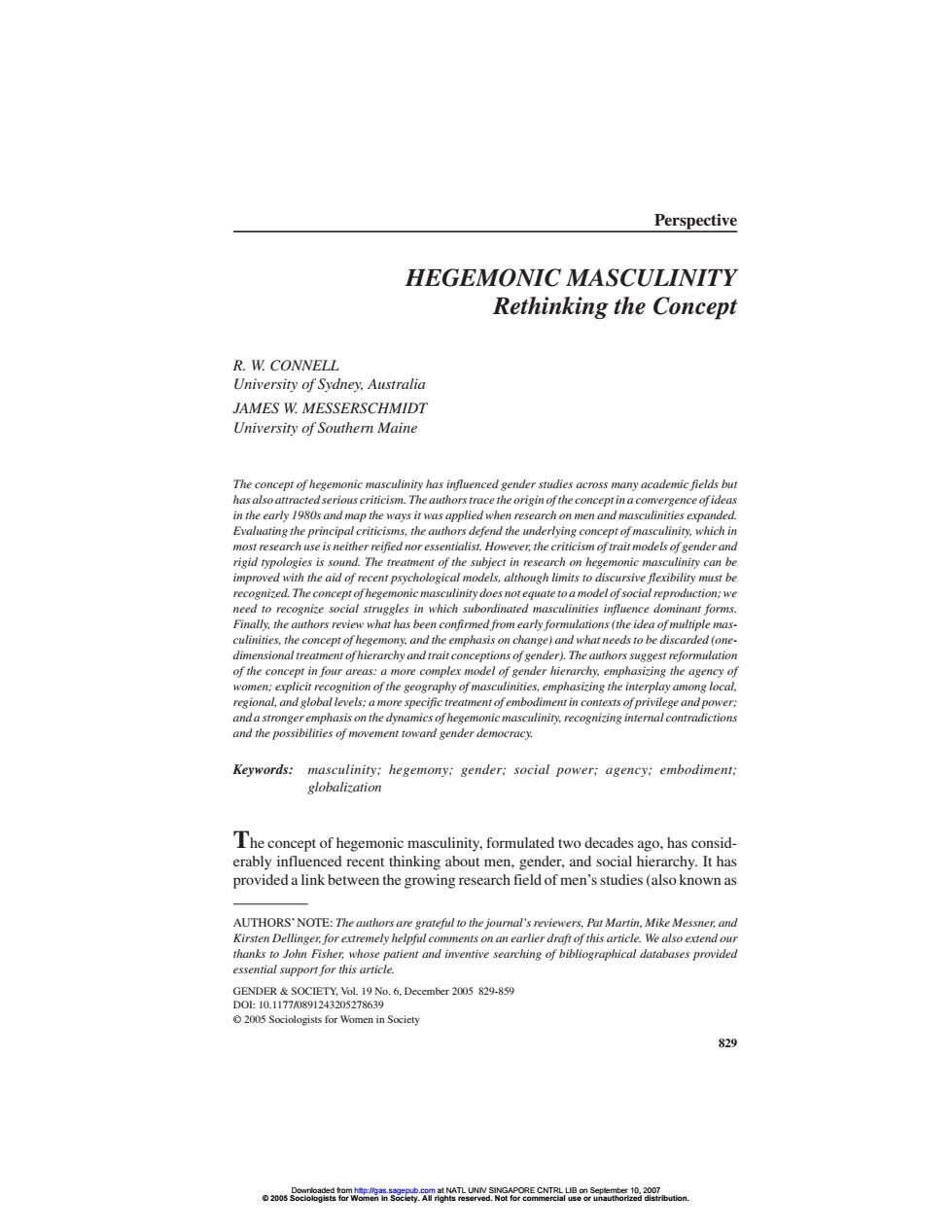正在加载图片...

Perspective HEGEMONIC MASCULINITY Rethinking the Concept R.W.CONNELL University of Sydney,Australia JAMES W.MESSERSCHMIDT University of Southern Maine The concept of hegemonic masculiniry has influenced gender studies across many academic fields but has also attracted serious criticism.The authors trace the origin of the concept in a convergence of ideas in the early 1980s and map the ways it was applied when research on men and masculinities expanded. Evaluating the principal criticisms,the authors defend the underlying concept of masculinity,which in most research use is neither reified nor essentialist.However,the criticism of trait models of gender and rigid typologies is sound.The treatment of the subject in research on hegemonic masculinity can be improved with the aid of recent psychological models,although limits to discursive flexibiliry must be recognized.The concept of hegemonic masculinity does not equate to a model of social reproduction;we need to recognize social struggles in which subordinated masculinities influence dominant forms. Finally,the authors review what has been confirmed from early formulations (the idea of multiple mas- culinities,the concept of hegemony,and the emphasis on change)and what needs to be discarded (one- dimensional treatment of hierarchy and trait conceptions of gender).The authors suggest reformulation of the concept in four areas:a more complex model of gender hierarchy,emphasizing the agency of women;explicit recognition of the geography of masculinities,emphasizing the interplay among local, regional,and global levels;a more specific treatment of embodiment in contexts of privilege and power; and a stronger emphasis on the dynamics of hegemonic masculinity,recognizing internal contradictions and the possibilities of movement toward gender democracy. Keywords:masculinity:hegemony:gender:social power:agency:embodiment: globalization The concept of hegemonic masculinity,formulated two decades ago,has consid- erably influenced recent thinking about men,gender,and social hierarchy.It has provided a link between the growing research field of men's studies(also known as AUTHORS'NOTE:The authors are grateful to the journal's reviewers,Pat Martin,Mike Messner.and Kirsten Dellinger.for extremely helpful comments on an earlier draft of this article.We also extend our thanks to John Fisher,whose patient and inventive searching of bibliographical databases provided essential support for this article. GENDER SOCIETY.Vol.19 No.6.December 2005 829-859 D0L:10.11770891243205278639 2005 Sociologists for Women in Society 829 o2osS6eoege8rmee3g"3eaR4T0mt6o2ECTElB。crmom28aGC7buton10.1177/0891243205278639 GENDER & SOCIETY / December 2005 Connell, Messerschmidt / HEGEMONIC MASCULINITY Perspective HEGEMONIC MASCULINITY Rethinking the Concept R. W. CONNELL University of Sydney, Australia JAMES W. MESSERSCHMIDT University of Southern Maine The concept of hegemonic masculinity has influenced gender studies across many academic fields but has also attracted serious criticism. The authors trace the origin of the concept in a convergence of ideas in the early 1980s and map the ways it was applied when research on men and masculinities expanded. Evaluating the principal criticisms, the authors defend the underlying concept of masculinity, which in most research use is neither reified nor essentialist. However, the criticism of trait models of gender and rigid typologies is sound. The treatment of the subject in research on hegemonic masculinity can be improved with the aid of recent psychological models, although limits to discursive flexibility must be recognized. The concept of hegemonic masculinity does not equate to a model of social reproduction; we need to recognize social struggles in which subordinated masculinities influence dominant forms. Finally, the authors review what has been confirmed from early formulations (the idea of multiple masculinities, the concept of hegemony, and the emphasis on change) and what needs to be discarded (onedimensional treatment of hierarchy and trait conceptions of gender). The authors suggest reformulation of the concept in four areas: a more complex model of gender hierarchy, emphasizing the agency of women; explicit recognition of the geography of masculinities, emphasizing the interplay among local, regional, and global levels; a more specific treatment of embodiment in contexts of privilege and power; and a stronger emphasis on the dynamics of hegemonic masculinity, recognizing internal contradictions and the possibilities of movement toward gender democracy. Keywords: masculinity; hegemony; gender; social power; agency; embodiment; globalization The concept of hegemonic masculinity, formulated two decades ago, has considerably influenced recent thinking about men, gender, and social hierarchy. It has provided a link between the growing research field of men’s studies (also known as 829 Y AUTHORS’NOTE: The authors are grateful to the journal’s reviewers, Pat Martin, Mike Messner, and Kirsten Dellinger, for extremely helpful comments on an earlier draft of this article. We also extend our thanks to John Fisher, whose patient and inventive searching of bibliographical databases provided essential support for this article. GENDER & SOCIETY, Vol. 19 No. 6, December 2005 829-859 DOI: 10.1177/0891243205278639 © 2005 Sociologists for Women in Society © 2005 Sociologists for Women in Society. All rights reserved. Not for commercial use or unauthorized distribution. Downloaded from http://gas.sagepub.com at NATL UNIV SINGAPORE CNTRL LIB on September 10, 2007